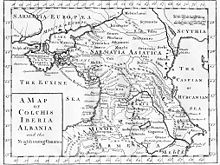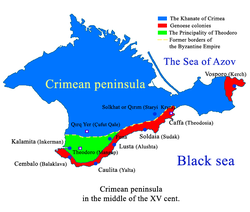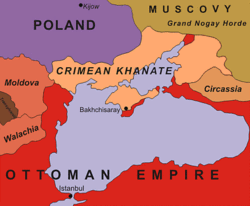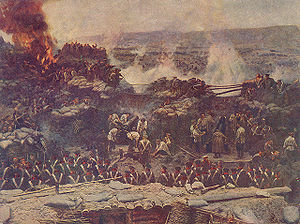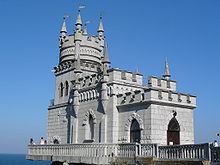- History of Crimea
-
Location of Crimea (dark green) with respect to Ukraine (light green) on a map of Europe

Crimea, a peninsula on the northern coast of the Black Sea and an autonomous republic under the jurisdiction of Ukraine, has a history of over 2000 years. The territory of Crimea has been conquered and controlled many times throughout this history. The Cimmerians, Greeks, Scythians, Goths, Huns, Bulgars, Khazars, the state of Kievan Rus', Byzantine Greeks, Kipchaks, Ottoman Turks, Golden Horde Tatars and the Mongols all controlled Crimea in its early history. In the 13th century, it was partly controlled by the Venetians and by the Genovese; they were followed by the Crimean Khanate and the Ottoman Empire in the 15th to 18th centuries, the Russian Empire in the 18th to 20th centuries, the Russian Soviet Federative Socialist Republic and later the Ukrainian Soviet Socialist Republic within the Soviet Union in the rest of the 20th century, and Germany during World War II.
The name "Crimea" takes its origin in the name of the city of Qırım (today called Stary Krym) which served as a capital of the Crimean province of the Golden Horde. The ancient Greeks called Crimea Tauris (later Taurica), after its inhabitants, the Tauri.
Taurica was eventually renamed by the Crimean Tatars, from whose language the Crimea's modern name derives. The word "Crimea" comes from the Crimean Tatar name Qırım, via Greek Krimeía (Κριμαία).
After the annexation of Crimea in 1783 the newly-installed Russian authorities made an attempt to revive the ancient name, and the former lands of the Crimean Khanate were organized into the Taurida Governorate. But this name was used only in the official documents and "Crimea" remained a common name for the country.
Contents
Early history
Main article: TauricaTaurica (Greek: Ταυρίς, Ταυρίδα) also known as Tauris, Taurida, Tauric Chersonese and Chersonesus Taurica was the name of Crimea in antiquity.
The earliest inhabitants of whom we have any authentic traces were the Cimmerians, who were expelled by the Scythians during the 7th century BC. The inland regions were then inhabited by Scythians and the mountainous south coast by the remaining Cimmerians, who became known as the Tauri.
According to Greek legends, Tauris is the place to which Iphigeneia was sent after the goddess Artemis rescued her from the human sacrifice her father was about to perform. The goddess swept the young princess off to Tauris where she became a priestess at her temple. Here, she was forced by the Taurian king Thoas to perform human sacrifices on any foreigners who came ashore. According to other historians, the Tauri were known for their savage rituals and piracy and were also the earliest indigenous peoples of the peninsula. The land of Tauris and its rumored customs of killing Greeks are also described by Herodotus in his histories, Book IV, 99–100 and 103.
The Ancient Greeks in turn named the region after the Tauri. As the Tauri inhabited only mountainous regions of southern Crimea at first the name Tauris was used only to this southern part, but later it was extended to name the whole peninsula.
Sometimes Taurica is referred to as Tauric Chersonese or Chersonesus Taurica. This name is Greek for the "Tauric peninsula" (Chersonese literally means "peninsula"). This variant of the name should not be confused with the city of Chersonesos.
 Greek colonies along the north coast of the Black Sea in the 5th century BCE.
Greek colonies along the north coast of the Black Sea in the 5th century BCE.
In the 5th century BC Greek colonists began to settle along the Black Sea coast; among them were the Dorians from Heraclea who founded a sea port of Chersonesos outside modern Sevastopol and the Ionians from Miletus who landed at Feodosiya and Panticapaeum (also called Bosporus).
In 438 BC, the Archon (ruler) of the latter settlers assumed the title of the King of Cimmerian Bosporus, a state that maintained close relations with Athens, supplying the city with wheat, honey and other commodities. The last of that line of kings, Paerisades V, being hard-pressed by the Scythians, put himself under the protection of Mithridates VI, the king of Pontus, in 114 BC. After the death of this sovereign, his son, Pharnaces II, was invested by Pompey with the Kingdom of Bosporus in 63 BC as a reward for the assistance rendered to the Romans in their war against his father. In 15 BC, it was once again restored to the king of Pontus, but from then ranked as a tributary state of Rome.
Roman Crimea
Main article: Roman CrimeaIn the 2nd century BC, the eastern part of Taurica became part of the Bosporan Kingdom, before being incorporated into the Roman Empire in the 1st century BC.
During the AD 1st, 2nd and 3rd centuries, Taurica was host to Roman legions and colonists in Charax, Crimea. The Charax colony was founded under Vespasian with the intention of protecting Chersonesos and other Bosporean trade emporiums from the Scythians. The Roman colony was protected by a vexillatio of the Legio I Italica; it also hosted a detachment of the Legio XI Claudia at the end of the 2nd century. The camp was abandoned by the Romans in the mid-3rd century. This de facto province would have been controlled by the legatus of one of the Legions stationed in Charax.
Crimea in the Middle Ages
Throughout the later centuries, Crimea was invaded or occupied successively by the Goths (AD 250), the Huns (376), the Bulgars (4th–8th century), the Khazars (8th century), the state of Kievan Rus' (10th–11th centuries), the Byzantine Empire (1016), the Kipchaks (the Kumans) (1050), and the Mongols (1237).
In the mid-10th century, the eastern area of Crimea was conquered by Prince Sviatoslav I of Kiev and became part of the Kievan Rus' principality of Tmutarakan. In 988, Prince Vladimir I of Kiev also captured the Byzantine town of Chersones (presently part of Sevastopol) where he later converted to Christianity. An impressive Russian Orthodox cathedral marks the location of this historic event.
In the 13th century, the Republic of Genoa seized the settlements which their rivals, the Venetians, had built along the Crimean coast and established themselves at Cembalo (now Balaklava), Soldaia (Sudak), Cherco (Kerch) and Caffa (Feodosiya), gaining control of the Crimean economy and the Black Sea commerce for two centuries.[citation needed]
Crimean Khanate: 1441–1783
Main article: Crimean KhanateFile:Hansaray.jpgA number of Turkic peoples, now collectively known as the Crimean Tatars, have been inhabiting the peninsula since the early Middle Ages. The ethnicity of the Crimean Tatars is quite complex as it absorbed both nomadic Turkic and European components (including, at first, the Goths and the Genoese) which is still reflected in their appearance and language differences. A small enclave of the Karaims, possibly of Khazar (i.e. Turkic) descent but members of a Jewish sect, was founded in the 8th century. It existed among the Muslim Crimean Tatars, primarily in the mountainous Çufut Qale area.
In 1346, the bodies of Mongol warriors of the Golden Horde who had died of plague were thrown over the walls of the besieged Kaffa (now Feodosiya). It has been speculated that this operation may have been responsible for the advent of the Black Death in Europe.[1]
After the destruction of the Golden Horde by Timur in 1441, the Crimean Tatars founded an independent Crimean Khanate under Hacı I Giray, a descendant of Genghis Khan. He and his successors reigned first at Qırq Yer, and from the beginning of the 15th century, at Bakhchisaray.[2]
The Crimean Tatars controlled the steppes that stretched from the Kuban and to the Dniester River, however, they were unable to take control over commercial Genoese towns. After the Crimean Tatars asked for help from the Ottomans, an Ottoman invasion of the Genoese towns led by Gedik Ahmed Pasha in 1475 brought Kaffa and the other trading towns under their control.[3]:78
After the capture of Genoese towns, the Ottoman Sultan held Meñli I Giray captive,[4] later releasing him in return for accepting Ottoman suzerainty over the Crimean Khans and allowing them rule as tributary princes of the Ottoman Empire.[3]:78[5] However, the Crimean Khans still had a large amount of autonomy from the Ottoman Empire, particularly, followed the rules they thought were best for them: Crimean Tatars introduced raids into Ukrainian lands, which were used to get slaves to be sold on markets.[3]:78 For example, from 1450 to 1586, eighty-six Tatar raids were recorded, and from 1600 to 1647, seventy.[3]:106 In the 1570s close to 20,000 slaves a year were being sold in Kaffa.[6]
In 1553–1554, Cossack Hetman Dmytro Vyshnevetsky gathered together groups of Cossacks, and constructed a fort designed to obstruct Tatar raids into Ukraine. With this action, he founded the Zaporozhian Sich, with which he would launch a series of attacks on the Crimean Peninsula and the Ottoman Turks.[3]:109 In 1774, the Crimean Khans fell under Russian influence with the Treaty of Küçük Kaynarca.[3]:176 In 1778, numerous Greek Orthodox residents were deported from Crimea to the vicinity of Mariupol by the Russian government.[7] In 1783, the entire Crimea was annexed by the Russian Empire.[3]:176
Crimea in the Russian Empire: 1783–1917
See also: New Russia and Taurida Governorate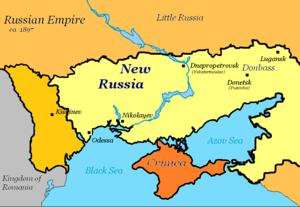 A map of what was called New Russia during the time of the Russian Empire. Only the parts of New Russia that are now in Ukraine are shown.
A map of what was called New Russia during the time of the Russian Empire. Only the parts of New Russia that are now in Ukraine are shown.
The Taurida Oblast was created by a decree of Catherine the Great on 2 February 1784. The center of the oblast was first in Karasubazar but was moved to Simferopol later in 1784. The establishment decree divided the oblast the area was divided into 7 uyezds. However, by a decree of Paul I on 12 December 1796, the oblast was abolished and the territory, divided into 2 uyezds (Akmechetsky [Акмечетский] and Perekopsky [Перекопский]) was attached to the second incarantion of the Novorossiysk Governorate.
After 1799, the territory was divided into uyezds. At that time, there were 1,400 inhabited villages and 7 towns—Simferopol, Sevastopol, Yalta, Yevpatoria, Alushta, Feodosiya, and Kerch.
In 1802, in the course of Paul I's administrative reform of areas that were annexed from the Crimean Khanate, the Novorossiysk Governorate was again abolished and subdivided. Crimea was attached to a new Taurida Governorate established with its centre at Simferopol. The governorate included both the 25,133 km² Crimea as well as 38,405 km² of adjacent areas of the mainland.
By the late 19th century, Crimean Tatars continued to form a slight plurality of Crimea's still largely rural population but there were large numbers of Russians and Ukrainians as well as smaller numbers of Germans, Jews (including Krymchaks and Crimean Karaites), Bulgarians, Belarussians, Turks, Armenians, and Greeks and Gypsies.
The Tatars were the predominant portion of the population in the mountainous area and about half of the steppe population. Russians were concentrated most heavily in Feodosiya district. Germans and Bulgarians settled in the Crimea at the beginning of 19th century, receiving a large allotment and fertile land and later wealthy colonists began to buy land, mainly in Perekopsky and Evpatoria uyezds.
Crimean War
Main article: Crimean WarThe Crimean War (1853–1856), a conflict fought between the Russian Empire and an alliance of the French Empire, the British Empire, the Ottoman Empire, the Kingdom of Sardinia, and the Duchy of Nassau, was part of a long-running contest between the major European powers for influence over territories of the declining Ottoman Empire. While some of the war was fought elsewhere, the principal engagements were in Crimea.
Following action in the Danubian Principalities and in the Black Sea, allied troops landed in Crimea in September 1854 and besieged the city of Sevastopol, home of the Tsar's Black Sea Fleet and the associated threat of potential Russian penetration into the Mediterranean. After extensive fighting throughout Crimea, the city fell on 9 September 1855.
The war devastated much of the economic and social infrastructure of Crimea. The Crimean Tatars had to flee from their homeland en masse, forced by the conditions created by the war, persecution and land expropriations. Those who survived the trip, famine and disease, resettled in Dobruja, Anatolia, and other parts of the Ottoman Empire. Finally, the Russian government decided to stop the process, as the agriculture began to suffer due to the unattended fertile farmland.
The Swallow's Nest, a symbol of Crimea, one of the best-known, romantic castles near Yalta. It was built in 1912 in the Neo-Gothic style by the order of the German Baron Stengel. It was designed by Russian architect A. Sherwood.
Crimea in the Russian Civil War: 1917–1921
Following the Russian Revolution of 1917, the military and political situation in Crimea was chaotic like that in much of Russia. During the ensuing Russian Civil War, Crimea changed hands numerous times and was for a time a stronghold of the anti-Bolshevik White Army. It was in Crimea that the White Russians led by General Wrangel made their last stand against Nestor Makhno and the Red Army in 1920. When resistance was crushed, many of the anti-Communist fighters and civilians escaped by ship to Istanbul.
 A 25-ruble banknote of the Crimean Regional Government
A 25-ruble banknote of the Crimean Regional Government
Crimea changed hands several times over the course of the conflict and several political entities were set up on the peninsula. These included:
- Crimean People's Republic — December 1917–January 1918 — Crimean Tatar government
- Taurida Soviet Socialist Republic — 19 March 1918–30 April 1918 — Bolshevik government
- German and Ukrainian People's Republic occupation — May 1918–June 1918
- First Crimean Regional Government — 25 June 1918–25 November 1918 — German puppet state under Lipka Tatar General Maciej (Suleyman) Sulkiewicz
- Second Crimean Regional Government — November 1918–April 1919 — Anti-Bolshevik government under Crimean Karaite former Kadet member Solomon Krym
- Crimean Socialist Soviet Republic — 2 April 1919–June 1919 — Bolshevik government
- South Russian Government — February 1920–April 1920 — Government of White movement's General Anton Denikin
- Government of South Russia — April 1920 (officially, 16 August 1920)–16 November 1920 — Government of White movement's General Pyotr Wrangel
- Bolshevik Revolutionary committee government — November 1920–18 October 1921 — Bolshevik government under Béla Kun (until 20 February 1921), then Mikhail Poliakov
- Crimean Autonomous Socialist Soviet Republic — 18 October 1921–30 June 1945 — Autonomous republic of the RSFSR in the Soviet Union
Crimea in the Soviet Union: 1922–1991
Interbellum Soviet history
On October 18, 1921, the Crimean Autonomous Soviet Socialist Republic was created as part of the Russian SFSR which, in turn, became part of the new Soviet Union.[5] However, this did not protect the Crimean Tatars, who constituted about 25% of the Crimean population,[8] from Joseph Stalin's repressions of the 1930s.[5]
The Greeks were another cultural group that suffered. Their lands were lost during the process of collectivisation, in which farmers were not compensated with wages. Schools which taught Greek were closed and Greek literature was destroyed, because the Soviets considered the Greeks as "counter-revolutionary" with their links to capitalist state Greece, and their independent culture.[5]
Crimea experienced two severe famines in the 20th century, the Famine of 1921–1922 and the Holodomor of 1932–1933.[9]
World War II and ethnic deportations
See also: Deportation of the Crimean TatarsDuring World War II, Crimea was a scene of some of the bloodiest battles. The leaders of the Third Reich were anxious to conquer and colonize the fertile and beautiful peninsula as part of their policy of resettling the Germans in Eastern Europe at the expense of the Slavs. The Germans suffered heavy casualties in the summer of 1941 as they tried to advance through the narrow Isthmus of Perekop linking Crimea to the Soviet mainland. Once the German army broke through (Operation Trappenjagd), they occupied most of Crimea, with the exception of the city of Sevastopol, which was later awarded the honorary title of Hero City after the war. The Red Army lost over 170,000 men killed or taken prisoner, and three armies (44th, 47th, and 51st) with twenty-one divisions.[10]
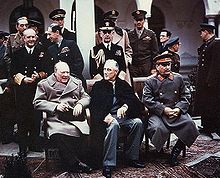 The "Big Three" at the Yalta Conference in Crimea: Winston Churchill, Franklin D. Roosevelt and Joseph Stalin.
The "Big Three" at the Yalta Conference in Crimea: Winston Churchill, Franklin D. Roosevelt and Joseph Stalin.
Sevastopol held out from October 1941 until 4 July 1942 when the Germans finally captured the city. From 1 September 1942, the peninsula was administered as the Generalbezirk Krim (general district of Crimea) und Teilbezirk (and sub-district) Taurien by the Nazi Generalkommissar Alfred Eduard Frauenfeld (1898–1977), under the authority of the three consecutive Reichskommissare for the entire Ukraine. In spite of heavy-handed tactics by the Nazis and the assistance of the Romanian and Italian troops, the Crimean mountains remained an unconquered stronghold of the native resistance (the partisans) until the day when the peninsula was freed from the occupying force.
In 1944, Sevastopol came under the control of troops from the Soviet Union. The so-called "City of Russian Glory" once known for its beautiful architecture was entirely destroyed and had to be rebuilt stone by stone. Due to its enormous historical and symbolic meaning for the Russians, it became a priority for Stalin and the Soviet government to have it restored to its former glory within the shortest time possible.
On 18 May 1944, the entire population of the Crimean Tatars were forcibly deported in the "Sürgün" (Crimean Tatar for exile) to Central Asia by Stalin's Soviet government as a form of collective punishment on the grounds that they had collaborated with the Nazi occupation forces.[3]:483 An estimated 46% of the deportees died from hunger and disease. On 26 June of the same year Armenian, Bulgarian and Greek population was also deported to Central Asia. By the end of summer 1944, the ethnic cleansing of Crimea was complete. In 1967, the Crimean Tatars were rehabilitated, but they were banned from legally returning to their homeland until the last days of the Soviet Union. The Crimean Autonomous Soviet Socialist Republic was abolished in 30 June 1945 and transformed into the Crimean Oblast (province) of the Russian SFSR.
Post-war Soviet history
See also: Crimean OblastOn 19 February 1954, the Presidium of the Supreme Soviet of the USSR issued a decree on the transfer of the Crimean region of the RSFSR to the Ukrainian SSR. This Supreme Soviet Decree states that this transfer was motivated by "the commonality of the economy, the proximity, and close economic and cultural relations between the Crimean region and the Ukrainian SSR".[11]
In post-war years, Crimea thrived as a prime tourist destination, built with new attractions and sanatoriums for tourists. Tourists came from all around the Soviet Union and neighbouring countries, particularly from the German Democratic Republic.[5] Also, Crimea's infrastructure and manufacturing also developed, particularly around the sea ports at Kerch and Sevastopol and in the oblast's landlocked capital, Simferopol. Populations of Ukrainians and Russians alike doubled, with more than 1.6 million Russians and 626,000 Ukrainians living on the peninsula by 1989.[5]
Crimea within independent Ukraine
Establishment of the Autonomous Republic: 1991–1998
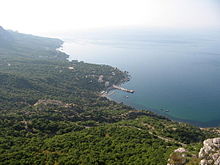 Crimea's southernmost point is the Cape of Sarych on the northern shore of the Black Sea, currently used by the Russian Navy.
Crimea's southernmost point is the Cape of Sarych on the northern shore of the Black Sea, currently used by the Russian Navy.
With the collapse of the Soviet Union, Crimea became part of the newly independent Ukraine, a situation largely unexpected by its population.[citation needed] Independence was supported by a referendum in all regions of Ukrainian SSR, including Crimea.[12] 54% of the Crimean voters supported independence with a 60% turnout (in Sevastopol 57% supported independence).[13][14] This new situation led to tensions between Russia and Ukraine. With the Black Sea Fleet based on the peninsula, worries of armed skirmishes were occasionally raised. In August 1991, Yuriy Meshkov established the Republican Movement of Crimea which was registered on 19 November.
On 2 September 1991, the National Movement of Crimean Tatars appealed to the V Extraordinary Congress of People's Deputies in Russia demanding the program how to return the deported Tatar population back to Crimea. Based on the resolution of the Verkhovna Rada (the Crimean parliament) on 26 February 1992, the Crimean ASSR was renamed the Republic of Crimea. Crimea proclaimed self-government on May 5, 1992,[15][16] and on the next day passed the first Crimean constitution.
On 19 May, Crimea agreed to remain as part of Ukraine and annulled their proclamation of self-government. By 30 June, Crimean Communists forced the Kiev government to expand on the already extensive autonomous status of Crimea.[3]:587 In the same period, Russian president Boris Yeltsin and Ukraine's Leonid Kravchuk agreed to divide the former Soviet Black Sea Fleet between Russia and the newly formed Ukrainian Navy.[17] On 24 October, Meshkov re-registered his movement as the Republican Party of Crimea – Party of the Republican Movement of Crimea. On 11 December 1992, the President of Ukraine called the attempt of "the Russian deputies to charge the Russian parliament with a task to define the status of Sevastopol as an imperial disease".[18] On 17 December 1992, the office of the Ukrainian presidential representative in Crimea was created, which caused wave of protests a month later. Among the protesters that created the unsanctioned rally were the Sevastopol branches of the National Salvation Front, the Russian Popular Assembly, and the All-Crimean Movement of the Voters for the Republic of Crimea. The protest was held in Sevastopol on 10 January at Nakhimov Square.
On 15 January 1993, Kravchuk and Yeltsin in the meeting in Moscow appointed Eduard Baltin as the commander of the Black Sea Fleet. At the same time the Union of the Ukrainian Naval Officers protested the Russian intervention into the Ukrainian internal affairs. Soon after that there were more anti-Ukrainian protests led by the Meshkov's party, the Voters for the Crimean Republic, Yedinstvo, and the Union of Communists that demanded to turn Sevastopol under the Russian jurisdiction and followed by the interview given by the Sevastopol's Communist, Vasyl Parkhomenko, who said that the city's Communists request to recognize the Russian as the state language and restoration of the Soviet Union. On 19 March 1993, the Crimean deputy and the member of the National Salvation Front, Alexander Kruglov, threatened the members of the Crimean Ukrainian Congress not allow into the building of the Republican Council. Couple of days after that Russia established an information center in Sevastopol. In April 1993, the Ukrainian Ministry of Defence submitted an appeal to Verkhovna Rada to suspend the Yalta Agreement of 1992 that divided the Black Sea Fleet that was followed by the request from the Ukrainian Republican Party to recognize the Fleet either fully Ukrainian or a fleet of a foreign country in Ukraine. Also over 300 Russian legislators called the planned Congress of Ukrainian Residents a political provocation.
On 14 April 1993, the Presidium of the Crimean parliament called for the creation of the presidential post of the Crimean Republic. A week later the Russian deputy, Valentin Agafonov, stated that Russia is ready to supervise the referendum on Crimean independence and include the republic as a separate entity in the CIS. On 28 July 1993, one of the leaders of the Russian Society of Crimea, Viktor Prusakov, stated that his organization is ready for an armed mutiny and establishment of the Russian administration in Sevastopol. In September, Eduard Baltin accused Ukraine of converting some of his fleet and conducting an armed assault on his personnel, and threatened to take countermeasures of placing the fleet on alert.
On 14 October 1993, the Crimean parliament established the post of President of Crimea and agreed on the quota of the Crimean Tatars representation in the Council to 14. The head of the Russian People's Council in Sevastopol, Alexander Kruglov, called it excessive. The chairman of the Tatar Mejlis, Mustafa Cemiloglu (Djemilev), used words "categorically against" in regards to the proposed election for Crimean president on 16 January. He stated that there cannot be two presidents in a single state. On 6 November, the Crimean Tatar leader, Yuriy Osmanov was murdered. Series of terrorist actions rocked the peninsula in the winter among them were the arson of the Mejlis apartment, the shooting of a Ukrainian official, several hooligan attacks on Meshkov, the bomb explosion in the house of a local parliamentary, the assassination attempt on a Communist presidential candidate, and others. On 2 January 1994, the Mejlis announced a boycott of the presidential elections, which were later canceled. The boycott itself was later taken on by other Crimean Tatar organizations. On 11 January, the Mejlis announced their representative, Mykola Bahrov, the speaker of the Crimean parliament, as the presidential candidate. On 12 January, some other candidates accused Bahrov of severe methods of agitation. At the same time, Vladimir Zhirinovsky called on the people of Crimea to vote for the Russian Sergei Shuvainikov.
On 30 January 1994, the pro-Russian Yuriy Meshkov was elected to the new post but quickly ran into conflicts with parliament. On 8 September, the Crimean parliament degraded the President's powers from the head of state to the head of the executive power only, to which Meshkov responded by disbanding parliament and announcing his control over Crimea four days later. Amendments[clarification needed] to the constitution eased the conflict[citation needed], but on 17 March 1995, the parliament of Ukraine intervened, scrapping the Crimean Constitution and removing Meshkov along with his office for his actions against the state and promoting integration with Russia.[19] After an interim constitution lasting from 4 April 1996 to 23 December 1998, the current constitution was put into effect, changing the territory's name to the Autonomous Republic of Crimea.
Autonomous Republic of Crimea: 1999–present
Following the ratification of the May 1997 Treaty of Friendship, Cooperation, and Partnership on friendship and division of the Black Sea Fleet, international tensions slowly eased off. With the treaty, Moscow recognized Ukraine's borders and territorial integrity, and accepted Ukraine's sovereignty over Crimea and Sevastopol.[3]:600 In a separate agreement, Russia was to receive 80 percent of the Black Sea Fleet and use of the military facilities in Sevastopol on a 20-year lease.[3]:600
However, other controversies between Ukraine and Russia still remain, including the ownership of a lighthouse on Cape Sarych. Because the Russian Navy controlled 77 geographical objects on the south Crimean Shore, the Sevastopol Government Court ordered the vacating of the objects, which the Russian military did not carry out.[20] Since August 3, 2005, the lighthouse has been controlled by the Russian Army.[21] Through the years, there have been various attempts to return Cape Sarych to Ukrainian territory, all of which were unsuccessful.
In 2006, protests broke out on the peninsula after U.S. Marines[22] arrived at the Crimean city of Feodosiya to take part in the Sea Breeze 2006 Ukraine-NATO military exercise. Protesters greeted the marines with barricades and slogans bearing "Occupiers go home!" and a couple of days later, the Crimean parliament declared Crimea a "NATO-free territory." After several days of protest, the U.S. Marines withdrew from the peninsula.[23]
In September 2008, the Ukrainian Foreign Minister Volodymyr Ohryzko accused Russia of giving out Russian passports to the population in the Crimea and described it as a "real problem" given Russia's declared policy of military intervention abroad to protect Russian citizens.[24]
During a press conference in Moscow on 16 February 2009, the Mayor of Sevastopol Serhiy Kunitsyn claimed (citing recent polls) that the population of Crimea is opposed to the idea of becoming a part of Russia.[25]
Although western newspapers like the Wall Street Journal have speculated about a Russian coup in Sevastopol or another Crimean city in connection with the Russian-Georgian war and the Recognition of Abkhazia and South Ossetia by Russia.[26] Valentyn Nalyvaychenko, acting head of the Security Service of Ukraine (SBU), stated on 17 February 2009, that he is confident that any “Ossetian scenario” is impossible in Crimea.[27] The SBU had started criminal proceedings against the pro-Russian association "People's front Sevastopol-Crimea-Russia" in January 2009.[28]
On the 55th anniversary of the transfer of Crimea transfer of the Russian SFSR to the Ukrainian SSR (on 19 February 2009) some 300 to 500 people took part in rallies to protest against the transfer.[29][30]
On 24 August 2009, anti-Ukrainian demonstrations were held in Crimea by ethnic Russian residents. Sergei Tsekov (of the Russian Bloc[31] and then deputy speaker of the Crimean parliament[32]) said then that he hoped that Russia would treat the Crimea the same way as it had treated South Ossetia and Abkhazia.[33]
Chaos in the Verkhovna Rada (the Ukrainian parliament) during a debate over the extension of the lease on a Russian naval base erupted on 27 April 2010 after Ukraine’s parliament ratified the treaty that extends Russia’s lease on a military wharf and shore installations in the Crimean port Sevastopol until 2042. The Chairman of the Verkhovna Rada Volodymyr Lytvyn had to be shielded by umbrellas as he was pelted with eggs, while smoke bombs exploded and politicians brawled.[34][35] Along with the Verkhovna Rada the treaty was ratified by the Russian State Duma as well.[36]
Demographic history
For over two hundred years, Crimea has been an ethnically diverse region. In the beginning of the 18th century, Crimean Tatars formed a vast majority of the population of the peninsula. Although they continued to be a majority until the mid 19th century, many other groups migrated to the area. New populations of Russians, Ukrainians, Germans, and Jews mixed with the previous Crimean Tatar, Karaite, Greek, Armenian, Bulgarian, and Krymchak inhabitants.
By the late 19th century, Crimean Tatars continued to form a slight plurality of Crimea's still largely rural population but there were large numbers of Russians and Ukrainians as well as smaller numbers of Germans, Jews (including Krymchaks and Crimean Karaites), Bulgarians, Belarussians, Turks, Armenians, and Greeks and Gypsies.
The Tatars were the predominant portion of the population in the mountainous area and about half of the steppe population. Russians were concentrated most heavily in Feodosiya district. Germans and Bulgarians settled in the Crimea at the beginning of 19th century, receiving a large allotment and fertile land and later wealthy colonists began to buy land, mainly in Perekopsky and Evpatoria uyezds.
The upheavals and ethnic cleansing of the 20th century vastly changed Crimea's ethnic situation. In 1944, 70,000 Greeks and 14 000 Bulgarians from the Crimea were deported to Central Asia and Siberia,[37] along with 200,000 Crimean Tatars and other nationalities.[38] and, by the latter 20th century, Russians and Ukrainians made up almost the entire population. However, with the fall of the Soviet Union, exiled Crimean Tatars began returning to their homeland and, by the beginning of the 21st century were over 10% of the population.
Historical population statistics
- First quarter of 18th century — 467,000 total inhabitants (95.1% Crimean Tatars, 2.6% Greeks, 2.1% Armenians, 0.2% Krymchaks and Karaites)
- 1760s and 1770s — 454,700 (92.6% Crimean Tatars, 4% Greeks, 3.1% Armenians, 0.3% Krymchaks and Karaites)
- 1795 — 156,400 (87.6 % Crimean Tatars, 4.3% Russians, 1.9% Greeks, 1.7% Gypsies, 1.5% Karaites, 1.3% Ukrainians, 0.8% Jews, 0.6% Armenians, 0.1% Germans, 0.1% Bulgarians)
- 1816 — 212,600 (85.9% Crimean Tatars, 4.8% Russians, 3.7% Ukrainians, 1.4% Karaites, 1.3% Armenians, 0.9% Jews, 0.8% Greeks, 0.7% Germans, 0.4% Bulgarians)
- 1835 — 279,400 (83.5% Crimean Tatars, 4.4% Russians, 3.1% Ukrainians, 2.4% Gypsies, 2% Greeks, 1.5% Armenians, 1.1% Karaites, 0.9% Jews, 0.7% Germans, 0.4% Bulgarians)
- 1850 — 343,500 (77.8% Crimean Tatars, 7% Ukrainians, 6.6% Russians, 2% Greeks, 1.9% Gypsies, 1.3% Karaites, 1% Armenians, 1% Germans, 0.9% Jews, 0.5% Bulgarians)
- 1858 — 331,300 (73% Crimean Tatars, 12.6% Russians, 4% Ukrainians, 2.4% Greeks, 2% Gypsies, 1.8% Jews, 1.5% Germans, 1.3% Armenians, 0.8% Karaites, 0.6% Bulgarians)
- 1864 — 198,700 (50.3% Crimean Tatars, 28.5% Russians and Ukrainians, 6.5% Greeks, 5.3% Jews, 2.9% Armenians, 2.7% Germans, 1.7% Karaites, 1.6% Bulgarians)
- 1897 — 546,700 (35.6% Crimean Tatars, 33.1% Russians, 11.8% Ukrainians, 5.8% Germans, 4.4% Jews, 3.1% Greeks, 1.5% Armenians, 1.3% Bulgarians, 1.2% Poles, 0.3% Turks)
- 1917 — 749,800 (41.2% Russians, 28.7% Crimean Tatars, 8.6% Ukrainians, 6.4% Jews, 4.9% Germans, 2.9% Greeks, 1.6% Armenians, 1.4% Bulgarians, 0.8% Poles, 0.7% Turks)
- 1920 — 718,900 (44.1% Russians, 26% Crimean Tatars, 7.4% Ukrainians, 6.7% Jews, 5.9% Germans, 3.3% Greeks, 1.7% Armenians, 1.5% Bulgarians, 0.8% Karaites, 0.8% Poles)
- 1926 — 713,800 (42.2% Russians, 25.1% Crimean Tatars, 10.9% Ukrainians, 6.1% Germans, 5.5% Jews, 2.2% Greeks, 1.6% Armenians, 1.6% Bulgarians, 0.6% Karaites)
- 1934 — 832,000 (44% Russians, 23.8% Crimean Tatars, 10.9% Ukrainians, 8.1% Jews, 6.1% Germans, 1.7% Armenians, 1.4% Bulgarians)
- 1937 — 996,800 (47.7% Russians, 20.7% Crimean Tatars, 12.9% Ukrainians, 5.5% Jews, 5.1% Germans, 2.,2% Greeks, 1,5% Bulgarians, 0,3% Karaites)
- 1939 — 1,123,800 (49.6% Russians, 19.4% Crimean Tatars, 13.7% Ukrainians, 5.8% Jews, 4.5% Germans, 1.8% Greeks, 1.4% Bulgarians, 1.1% Armenians, 0.5% Poles)
- 1959 — 1,201,500 (71.4% Russians, 22.3% Ukrainians, 2.2% Jews, 0.1% Poles)
- 1979 — 2,135,900 (68.4% Russians, 25.6% Ukrainians, 1.1% Jews, 0.7% Crimean Tatars, 0.3% Poles, 0.2% Armenians, 0.2% Greeks)
- 1989 — 2,430,500 (67.1% Russians, 25.8% Ukrainians, 1.6% Crimean Tatars, 0.7% Jews, 0.3% Poles, 0.1% Greeks)
- 2001 — 2,024,056 (58.3% Russians, 24.3% Ukrainians, 12.1% Crimean Tatars, 1.4% Belarusians, 0.5% Tatars, 0.4% Armenians, 0.2% each of Jews, Poles, Moldovans and Azeris, 0.1% each of Uzbeks, Koreans (Koryo-saram), Greeks, Germans, Mordvins, Chuvashes, Gypsies, Bulgarians, Georgians and Maris, as well as Karaites, Krymchaks, and others)
References
- ^ Wheelis M. (2002), "Biological warfare at the 1346 siege of Caffa.", Emerg Infect Dis (Center for Disease Control), http://www.cdc.gov/ncidod/EID/vol8no9/01-0536.htm
- ^ The Tatar Khanate of Crimea
- ^ a b c d e f g h i j k Subtelny, Orest (2000). Ukraine: A History. University of Toronto Press. ISBN 0-8020-8390-0.
- ^ Soldier Khan
- ^ a b c d e f "History". blacksea-crimea.com. http://www.blacksea-crimea.com/history1.html. Retrieved March 28, 2007.
- ^ Halil Inalcik. "Servile Labor in the Ottoman Empire" in A. Ascher, B. K. Kiraly, and T. Halasi-Kun (eds), The Mutual Effects of the Islamic and Judeo-Christian Worlds: The East European Pattern, Brooklyn College, 1979, pp. 25–43.
- ^ Вадим Джувага "Одна з перших депортацій імперії. Як кримськими греками заселили Дике Поле". Історична правда. 17 February 2011. Retrieved 1 June 2011. (Ukrainian)
- ^ Crimea: History
- ^ Famine in Crimea
- ^ John Erickson (1975). The Road to Stalingrad: Stalin's War with Germany.
- ^ "The Transfer of Crimea to Ukraine". International Committee for Crimea. July 2005. http://www.iccrimea.org/historical/crimeatransfer.html. Retrieved March 25, 2007.
- ^ Nationalist Mobilization and the Collapse of the Soviet State by Mark R. Beissinger, Cambridge University Press, 2002, ISBN 978-0521001489 (page 197)
- ^ Russians in the Former Soviet Republics by Pål Kolstø, Indiana University Press, 1995, ISBN 978-0253329172 (page 191)
- ^ Ukraine and Russia:Representations of the Past by Serhii Plokhy, University of Toronto Press, 2008, ISBN 978-0802093271 (page 184)
- ^ Wolczuk, Kataryna (August 31 2004). "Catching up with 'Europe'? Constitutional Debates on the Territorial-Administrative Model in Independent Ukraine". Taylor & Francis Group. http://taylorandfrancis.metapress.com/openurl.asp?genre=article&issn=1359-7566&volume=12&issue=2&spage=65. Retrieved December 16, 2006.
- ^ Wydra, Doris (November 11 2004). "The Crimea Conundrum: The Tug of War Between Russia and Ukraine on the Questions of Autonomy and Self-Determination". SpringerLink. http://www.springerlink.com/content/b3e4b28e1301017b/. Retrieved March 25, 2007.
- ^ Ready To Cast Off, TIME Magazine, June 15, 1992
- ^ M.Drohobycky, xxxi
- ^ Laws of Ukraine. Verkhovna Rada law No. 93/95-вр: On the termination of the Constitution and some laws of the Autonomous Republic of Crimea. Passed on 1995-03-17. (Ukrainian)
- ^ "Access to Ukrainians is prohibited." (in Ukrainian). Zakryta Zona. Archived from the original on March 10, 2007. http://web.archive.org/web/20070310131212/http://www.zakrytazona.tv/ua/programs/pershiy-viddil/teksti/service/ukrayintsyam-vhid-zaboroneno/. Retrieved February 24, 2007.
- ^ "The owner of the "sarych" lighthouse came back with a blank document to the President of Ukraine" (in Ukrainian). CPCFPU. http://cpcfpu.org.ua/projects/foreignpolicy/headlines/security/internal/2302/. Retrieved February 24, 2007.
- ^ Page, Jeremy (June 8, 2006). "Anti-Nato protests threaten eastward expansion". The Times Online. London. http://www.timesonline.co.uk/tol/sport/football/european_football/article1083290.ece. Retrieved March 25, 2007.
- ^ "Tensions rise in Crimea over NATO". EuroNews. June 7 2006. http://euronews.net/create_html.php?page=detail_info&article=362919&lng=1. Retrieved March 25, 2007.[dead link]
- ^ Cheney urges divided Ukraine to unite against Russia 'threat. Associated Press. September 6, 2008.
- ^ Crimean population opposed to becoming part of Russia, UNIAN (16 February 2009)
- ^ Russia's Next Target Could Be Ukraine by Leon Aron, Wall Street Journal, September 10, 2008
- ^ Ossetian scenario impossible in Crimea – Nalyvaychenko, UNIAN, (February 17, 2009)
- ^ Security Service of Ukraine institutes criminal proceedings against association "People's front" Sevastopol-Crimea-Russia", Radio Ukraine (January 29, 2009)
- ^ Protestors in Crimea throw eggs at Khrushchev's portrait, RIA Novosti, (February 19, 2009)
- ^ Events by themes: Torch procession on occasion of 55th anniversary of Crimea to Ukraine passing, UNIAN photo service, (February 19, 2009)
- ^ [1], [[]] ()
- ^ [2], [[]] ()
- ^ Russia and Ukraine in Intensifying Standoff
- ^ http://news.bbc.co.uk/2/hi/europe/8645847.stm Parliamentary chaos as Ukraine ratifies fleet deal. Page last updated at 08:46 GMT, Tuesday, 27 April 2010 09:46 UK. BBC World
- ^ Protests in Kiev as Ukraine parliament approves Russia fleet treaty. The Hindu. KIEV, april 27, 2010.
- ^ Update: Ukraine, Russia ratify Black Sea naval lease, Kyiv Post (April 27, 2010)
- ^ "The Persecution of Pontic Greeks in the Soviet Union" (PDF)
- ^ "Crimean Tatars Divide Ukraine and Russia". The Jamestown Foundation. June 24, 2009.
See also
Categories:
Wikimedia Foundation. 2010.



